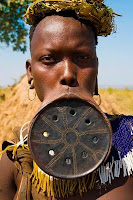Tattoo's aren't just a trend today, Tattoo's go as far back as when the ancient Egyptians existed. In Tribal communities especially, they represent something more meaningful than just a fashion statement. Tribal tattoo's can be seen as a sign of belonging to something, they almost act as a 'brand logo' to represent where you come from. Tattoo's within tribes can also mean things such as a religious statement, or even bravery, for example in Africa a tribe known as a 'Peul Tribe' would see someone applying a henna tattoo with a needle on their tongue very courageous. One of the most popular tribal tattoos known world wide is the Maori facial tattoo called Ta moko, where permanent grooves are carved in the skin.
 |
| Here is an example of my own version of a Maori carved tattoo onto a magazine image: |

Tattoo's are placed all over the body, one of the most common places tattoo's are placed are the hands. Such tattooing called 'Henna' is extremely common, especially within many indian cultures. Henna tattoo's are not permanent, they are usually seen in a light brown colour on the hands.
Here are my own observational illustrations of hands, then after adding my own henna designs onto the hands: using different media's, pen, pencil, charcoal etc I was able to design my own henna hand patterns.
The purpose of these hands linking is to represent what indian married couple would look like. As you can see I have added jewellery onto the woman's wrist, as jewellery to indian woman on their wedding day is vital! Also the point of this image is to show you the meaning of tattoo's, especially to these women, as most indian marriage's are arranged and the groom and bride normally can not see each other until the big day, and during the day the bride's face is covered up and only her hands and feet are on show hence why she has henna's done! Henna's for an indian bride are a way of showing beauty as the groom can not see any other part of her body, a beautiful henna tattoo will be very attractive to a groom. Thus body art has meaning!
Not every tribe uses tattoos as a form of body art, other tribes use raw materials to design a pattern onto their body. This image here I found on the picture website Tumblr, it was uploaded by beauty-of-africa. As you can see she has white circles drawn all over from her neck to her elbows, adding to the beautiful jewellery she has round her neck! I get the feeling that tribes do anything they can to enhance parts of the body or to give themselves a unique look to divide them from the rest of the world. To them it is most probably greatly attractive to have very bold bright colours on the skin carved into interesting patterns.
Not all tribes just paint the patterns onto the skin, other tribes believe body art has a much deeper meaning to it, literally. This photo is of a man from the Moari tribe, which are found in New Zealand. What you can see on his face is a form of body ate called Moko (or moari tattooing). Instead of using ink and needles which are needed for tattooing, Moko is much more indepth than that, to achieve Moko the skin must be cut and scarred to create curves and texture in the skin. It is not always just done on the face it can spread all over the body.Here is a video produced and presented by the National Geographic Channel on Scarification within tribes. Scarification is yet another way of modifying the body within many tribal cultures. Here the video show's what happens in the Bessoribe tribe, located in west Africa, and what happens when a boy becomes a man. The process of a male child leaving his childhood for adulthood is celebrated by creating scars on his abdominals. It is done by a fellow member of the tribe using sharpened scrap metal. The meaning of this scarification to a young male like this is that they are being courageous, and also that this is seen as attractive by other females he needs to impress!
 Other extreme body modifications are undertaken by many other tribes, such as inserting lip plates to stretch out the lips, or even teeth sharpening! In contrast to our british culture these acts are signs of importance, change, courage and simply to be unique in their own mysterious way.
Other extreme body modifications are undertaken by many other tribes, such as inserting lip plates to stretch out the lips, or even teeth sharpening! In contrast to our british culture these acts are signs of importance, change, courage and simply to be unique in their own mysterious way.



No comments:
Post a Comment